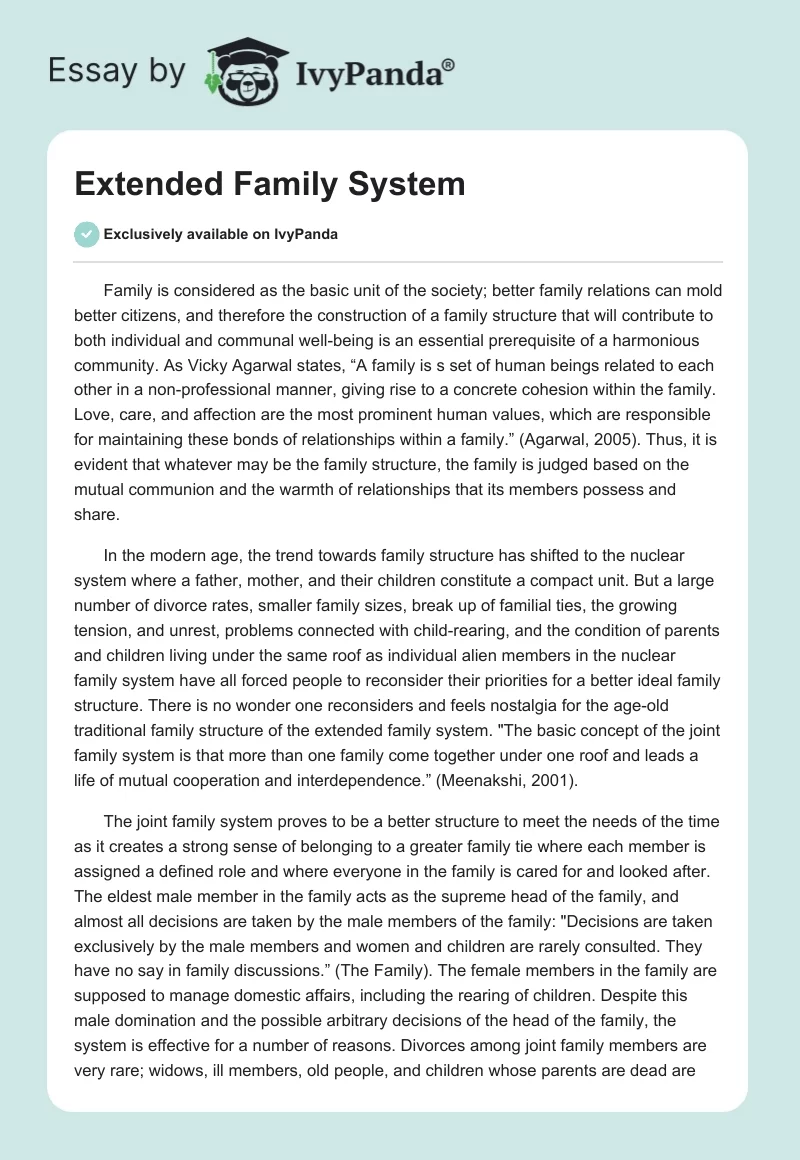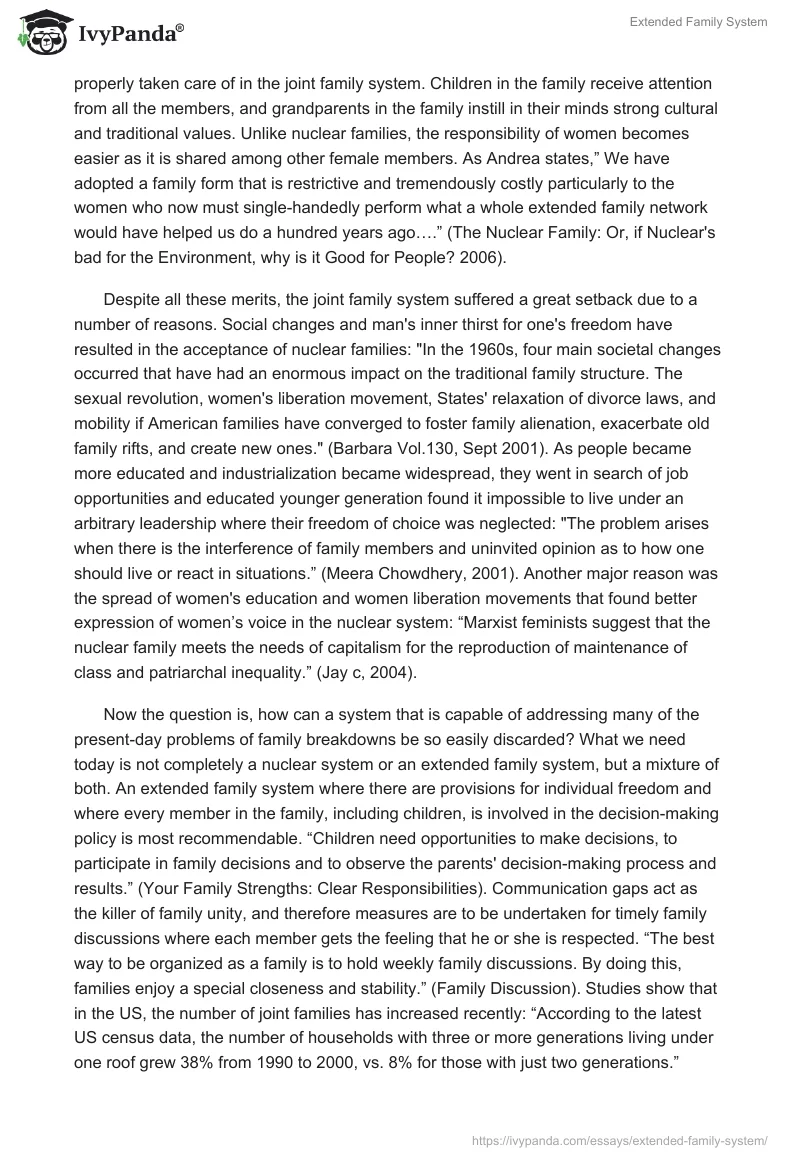Family is considered as the basic unit of the society; better family relations can mold better citizens, and therefore the construction of a family structure that will contribute to both individual and communal well-being is an essential prerequisite of a harmonious community. As Vicky Agarwal states, “A family is s set of human beings related to each other in a non-professional manner, giving rise to a concrete cohesion within the family. Love, care, and affection are the most prominent human values, which are responsible for maintaining these bonds of relationships within a family.” (Agarwal, 2005). Thus, it is evident that whatever may be the family structure, the family is judged based on the mutual communion and the warmth of relationships that its members possess and share.
In the modern age, the trend towards family structure has shifted to the nuclear system where a father, mother, and their children constitute a compact unit. But a large number of divorce rates, smaller family sizes, break up of familial ties, the growing tension, and unrest, problems connected with child-rearing, and the condition of parents and children living under the same roof as individual alien members in the nuclear family system have all forced people to reconsider their priorities for a better ideal family structure. There is no wonder one reconsiders and feels nostalgia for the age-old traditional family structure of the extended family system. “The basic concept of the joint family system is that more than one family come together under one roof and leads a life of mutual cooperation and interdependence.” (Meenakshi, 2001).
The joint family system proves to be a better structure to meet the needs of the time as it creates a strong sense of belonging to a greater family tie where each member is assigned a defined role and where everyone in the family is cared for and looked after. The eldest male member in the family acts as the supreme head of the family, and almost all decisions are taken by the male members of the family: “Decisions are taken exclusively by the male members and women and children are rarely consulted. They have no say in family discussions.” (The Family). The female members in the family are supposed to manage domestic affairs, including the rearing of children.
Despite this male domination and the possible arbitrary decisions of the head of the family, the system is effective for a number of reasons. Divorces among joint family members are very rare; widows, ill members, old people, and children whose parents are dead are properly taken care of in the joint family system. Children in the family receive attention from all the members, and grandparents in the family instill in their minds strong cultural and traditional values. Unlike nuclear families, the responsibility of women becomes easier as it is shared among other female members. As Andrea states,” We have adopted a family form that is restrictive and tremendously costly particularly to the women who now must single-handedly perform what a whole extended family network would have helped us do a hundred years ago….” (The Nuclear Family: Or, if Nuclear’s bad for the Environment, why is it Good for People? 2006).
Despite all these merits, the joint family system suffered a great setback due to a number of reasons. Social changes and man’s inner thirst for one’s freedom have resulted in the acceptance of nuclear families: “In the 1960s, four main societal changes occurred that have had an enormous impact on the traditional family structure. The sexual revolution, women’s liberation movement, States’ relaxation of divorce laws, and mobility if American families have converged to foster family alienation, exacerbate old family rifts, and create new ones.” (Barbara Vol.130, Sept 2001).
As people became more educated and industrialization became widespread, they went in search of job opportunities and educated younger generation found it impossible to live under an arbitrary leadership where their freedom of choice was neglected: “The problem arises when there is the interference of family members and uninvited opinion as to how one should live or react in situations.” (Meera Chowdhery, 2001). Another major reason was the spread of women’s education and women liberation movements that found better expression of women’s voice in the nuclear system: “Marxist feminists suggest that the nuclear family meets the needs of capitalism for the reproduction of maintenance of class and patriarchal inequality.” (Jay c, 2004).
Now the question is, how can a system that is capable of addressing many of the present-day problems of family breakdowns be so easily discarded? What we need today is not completely a nuclear system or an extended family system, but a mixture of both. An extended family system where there are provisions for individual freedom and where every member in the family, including children, is involved in the decision-making policy is most recommendable. “Children need opportunities to make decisions, to participate in family decisions and to observe the parents’ decision-making process and results.” (Your Family Strengths: Clear Responsibilities).
Communication gaps act as the killer of family unity, and therefore measures are to be undertaken for timely family discussions where each member gets the feeling that he or she is respected. “The best way to be organized as a family is to hold weekly family discussions. By doing this, families enjoy a special closeness and stability.” (Family Discussion). Studies show that in the US, the number of joint families has increased recently: “According to the latest US census data, the number of households with three or more generations living under one roof grew 38% from 1990 to 2000, vs. 8% for those with just two generations.” (Anne Tergesen. Thomson Gale. Cooperative Library System, 14 June 2007). Thus, one can possibly hope for a resurgence of the extended family system with the necessary changes of outlook and practice that suit the modern environment.
Works Cited
- Agarwal, Vikky. Analytic Views: Joint Family and Nuclear Family. Ezine Articles. Web.
- Jha, Meenakshi. In Defense of Joint Family System. Bologi.com.
- The Family. Web.
- The Nuclear Family: Or, if Nuclear’s bad for the environment, why is it good for people? Andrea.
- Lebey, Barbara. American Families are Drifting Apart. USA Today. Vol.130, 2001.
- Chowdhery, Meera. Viability of a Joint Family! Bologi.com. 2001.
- Jay, c. The Nuclear Family. Buzzle.com. 2004.
- Your Family Strengths: Clear Responsibilities. Family Ties. SKC Homepage. 2007.
- Family Discussion. Family Ties. SKC Homepage.
- Tergesen, Anne. Three Generations. One Roof; More and More Households are Doubling up. Here’s how to make it work. Business Week 3957. 2005. 92. Business and Company ASAP. Thomson Gale. Cooperative Library System, 2007.


